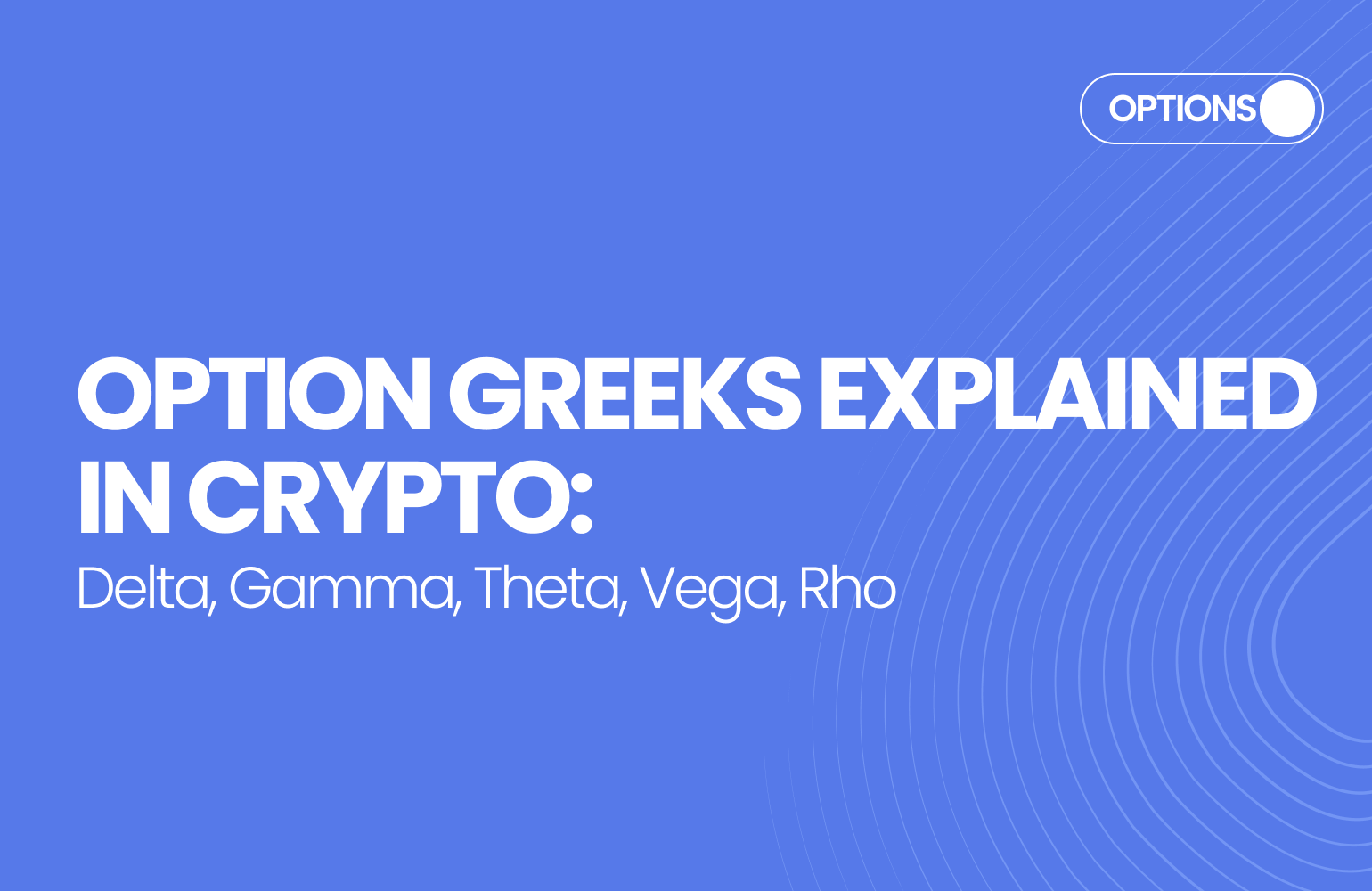Key Takeaways:
- Delta = direction, Gamma = rate of change, Theta = time decay
- Vega = volatility, Rho = interest rate impact
- Use crypto options greeks to build smarter, more balanced strategies
Trading crypto options without understanding the option greeks is like flying a plane blind. You may survive the turbulence, but you won’t be in control.
What are the Greeks in options? Delta, Gamma, Theta, Vega, and Rho are vital tools for managing risk, timing entries, and optimizing strategies. These metrics tell you how option trading reacts to changes in price, time, volatility, and even interest rates.
Read More: Trading With Implied Volatility Options
Whether you’re trading BTC or ETH options on Pi42, Deribit, or Binance, understanding option trading greeks gives you the edge that separates pros from gamblers.
What Are Option Greeks?
Options Greeks in trading refer to mathematical measures of how an option’s price reacts to market changes.
They answer key questions:
- What do the Greeks mean in options?
- What happens if BTC pumps?
- How fast will this option lose value with time?
- Will a volatility spike help or hurt me?
The 5 core option greeks in crypto are:
- Delta: Price movement
- Gamma: Delta acceleration
- Theta: Time decay
- Vega: Volatility sensitivity
- Rho: Interest rate sensitivity
Delta: Directional Sensitivity
Delta measures how much the price of an option changes for every $1 move in the underlying asset.
- Call options: Delta ranges from 0 to +1
- Put options: Delta ranges from 0 to -1
Example
If a BTC call option has a Delta of 0.6, and BTC rises by $1,000, the option price should increase by ~$600.
Use Cases
- High Delta = directional exposure
- Near expiry ITM calls can approach Delta 1 (almost like holding spot)
Pro Tip: Use Delta to estimate probability of expiring in-the-money.
Gamma: The Delta Accelerator
Gamma shows how much Delta changes when the price of the underlying asset changes. It’s essentially the speed of Delta.
Example
If Gamma is 0.05 and BTC moves by $1,000, your Delta increases by 0.05. If your Delta was 0.6, it becomes 0.65.
Why It Matters
- High Gamma = Delta can change quickly = more risk
- Gamma peaks for ATM options close to expiry
Strategy Tip
Gamma traders often rebalance positions frequently. Use caution when trading short Gamma strategies (e.g., naked short options).
Theta: The Silent Killer (Time Decay)
Theta measures how much value an option loses each day, all else equal. It’s the cost of time.
- Theta is negative for option buyers (you lose value daily)
- Theta is positive for sellers (you earn time premium)
Example
If Theta = -20, the option loses $20 in value per day, even if price doesn’t move.
Practical Tip
- Near-expiry options lose value faster (higher Theta)
- Sell options in high Theta environments if you’re looking to collect premium
Vega: Volatility Impact
Vega measures how sensitive an option is to changes in implied volatility (IV).
- Higher Vega = more affected by IV changes
- Long options (calls/puts) benefit from rising IV
Example
If Vega is 0.1, and IV rises 10%, the option gains $1.00 in value.
When to Use It
Expecting major events (CPI, ETF approvals)? Buy options before IV spikes. Sell options when IV is high and you expect it to drop.
Rho: The Interest Rate Greek
Rho measures how much an option’s price changes when interest rates move.
While often overlooked in crypto (where fiat rates are less direct), Rho can still affect longer-dated options and stablecoin-yielding strategies.
Example
If Rho is 0.05, and interest rates rise by 1%, the option gains $0.05 in value.
Crypto Context
Rho has more impact in traditional finance but may become more relevant as DeFi rates and tokenized treasury markets evolve.
Applying Greeks in Crypto Options Trading
Choose the Right Strategy
- High IV + High Vega? Try selling options (credit spreads)
- Low Theta + High Gamma? Buy ATM options for quick moves
Manage Risk
- Monitor Delta exposure to avoid directional over-leverage
- Be careful with Gamma on near-expiry trades
- Always track Theta if you’re long options
Tools to Track Greeks
- Pi42 Options Terminal: Real-time option greeks with visual overlays
- Deribit Analytics: IV surface and options greeks in crypto trading explorer
- TradingView: Add-on scripts for crypto options with greeks approximation
Conclusion: Read the Greeks Before You Trade
With the options Greeks explained, it becomes clear that these metrics are essential for every serious trader, not just quants.. Whether you want to profit from direction, volatility, or time, these tools tell you how your option will react.
Ready to apply the option greeks in crypto to your strategy? Try trading with full Greeks data on Pi42 today!
Frequently Asked Questions
Do crypto options have Greeks?
Yes, crypto options with Greeks use Delta, Gamma, Theta, Vega, and Rho to measure price, time, and volatility sensitivity. Most major exchanges now display these option greeks in crypto directly.
Which Greek is important for option buying?
For buyers, Delta and Vega matter most, showing price movement and volatility impact. Theta is also key since it tracks daily time decay.
How many Greeks are there in options?
There are five core options greeks explained—Delta, Gamma, Theta, Vega, and Rho. Advanced traders sometimes use secondary Greeks too.
Is high delta good for options in crypto?
High Delta means the option moves closely with the underlying crypto. It can be good for strong directional bets but reduces leverage benefits.

